Glastonbury Tor – One Of The Most Mysterious Sacred Places In England
A. Sutherland - AncientPages.com - Glastonbury Tor, some 525 feet high (160 m), has been called the 'Heart of England'.
It is an enigmatic sacred landmark, one of the most important early Christian sites in southern Britain, but first of all, a sacred pagan place for many centuries before the legendary arrival there of St. Joseph of Arimathea bearing the Holy Grail.

Glastonbury Abbey - Lady Chapel - image taken around 1900, showing the unrestored interior of the Lady Chapel. photo credits: wikipedia
It is an ancient sacred mound with the ruins of a legendary church standing atop it and dedicated to St. Michael, the Archangel, a warrior against powers of darkness.
The place is surrounded by numerous legends, going back through medieval times and continuing today.
A system of terraces that encircles Glastonbury Tor (Celtic word 'tor' means 'hill or mountain') has long been thought of as a gigantic labyrinth based on ancient pattern.
Was the Tor an important center of a fertility cult based on an earth goddess myth? Or is it the legendary island of Avalon associated with the grave of King Arthur?
Legends and myths, sometimes ancient carvings are our only legacy from secretful and strange places. Avalon was such a place, difficult to imagine and available only to a small circle of people.
Avalon - associated with Glastonbury Abbey - is said to be located in the county of Somerset,
It is sometimes said that the island of Avalon is hidden beneath the water's surface, but there is also a legend that describes the way to Avalon.

Joseph of Arimathea who brought the Holy Grail, filled with the blood of the crucified Christ, to England.
'One travels over water in a barque, but first one has to learn how to summon the barque and its crew. Only Avalon's inhabitants knew the land road, which never appears in the descriptions, although it is said that some people discover this secret path by mistake.
Cloud cover is another precondition for reaching Avalon, which cannot be entered in clear weather. Those who try to enter on a sunny day find themselves in Glastonbury Abbey.'
One of the greatest mysteries surrounding Glastonbury is whether or not King Arthur is buried here. In 1190, monks recorded that King arthur's mortal remains were placed beneath the abbey along with those of his wife Guinevere.
The king's Celtic grave has a lead cross with a Latin inscription:
"Hic jacet sepultus inclitus rex Arthurus in insula Avalonia" - "Here lies interred the famous King Arthur on the Isle of Avalon."
There is a number of theories regarding the Tor's origin and purpose and many people ask whether the mound is artificial.
'The answer is that it is a natural hill, but one that shows signs of having been artificially shaped. Along its sides are a number of terraces, one above another,' explains Geoffrey Ashe, a scholar and writer in the areas of Arthurian legend and British mythology.'

King Arthur's sword, Excalibur, was forged on the mystic Isle of Avalon. When Arthur was wounded in battle, he was carried off to the Isle of Avalon so that his wounds might be attended to.
Geoffrey Ashe, who wrote a book "King Arthur's Avalon" suggests that the Glastonbury Tor was intended as a ritual site that, when walked in procession, gave admittance to an interior world.
According to a theory put forward by Geoffrey Russell, Ashe says, the terraces are the principal remains of a maze: not in the sense of a puzzle, but in the sense of a long, twisting, devious approach to a centre. Made in the remote past for ritual purposes, it spirals round the Tor seven times, and ends - or may be supposed to end - at the summit where the tower now stands.
See also:
Medieval Mythbusting – New Research Rewrites History Of Glastonbury Abbey
Unraveling The Secret History Of King Arthur And Robin Hood
Was Tintagel Castle A Fortress Used By Iconic Hero King Arthur?
Using our imagination, we can see initiates and pilgrims walking along a twisting, seven-circuit path. It reminds an old children's game, in which the object is to take a strictly defined route. without short cuts, from the start 'Hell' to the finish 'Heaven'.
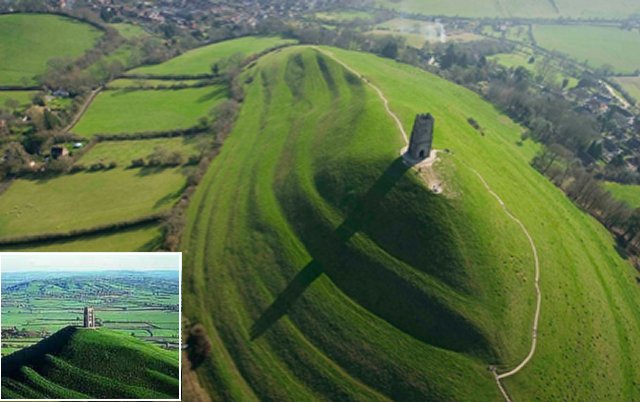
Glastonbury Tor in Somerset, England, enigmatic sacred mound; its rearing volcanic shape is surrounded by man-made serpentine paths
There is an old well the so-called Chalice Well, at the foot of the Tor where the water, blood red from the iron oxide in the surrounding bedrock, bubbles up with a specific sound like the heartbeat.
Legend says the well was built by the Druids to hide the cup used during the Last Supper, the Holy Grail, which was filled with the blood of the crucified Christ and brought to England by Joseph of Arimathea.
Others disagree saying the Chalice Well is probably a Victorian invention.
We know very little about the builders of Glastonbury Tor and its true meaning. Legends and myths cannnot give us satisfactory answers and despite modern theories, this enigmatic place still remains an unsolved enigma.
Written by – A. Sutherland AncientPages.com Staff Writer
Copyright © AncientPages.com All rights reserved. This material may not be published, broadcast, rewritten or redistributed in whole or part without the express written permission of AncientPages.com
Expand for referencesMore From Ancient Pages
-
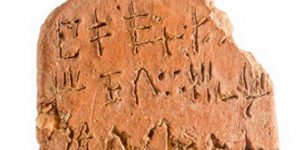 New Clues To Minoan Writing System
Archaeology | Sep 10, 2020
New Clues To Minoan Writing System
Archaeology | Sep 10, 2020 -
 Mysterious Ancient Structures Hidden Under The Sand In The Sahara Desert Could Re-Write History Of Ancient Egypt
Featured Stories | May 30, 2015
Mysterious Ancient Structures Hidden Under The Sand In The Sahara Desert Could Re-Write History Of Ancient Egypt
Featured Stories | May 30, 2015 -
 Miraculous Cauldrons Of The Ancient Celtic World
Myths & Legends | Apr 17, 2024
Miraculous Cauldrons Of The Ancient Celtic World
Myths & Legends | Apr 17, 2024 -
 Chromium Steel Was First Produced In Ancient Persia
Ancient Technology | Sep 24, 2020
Chromium Steel Was First Produced In Ancient Persia
Ancient Technology | Sep 24, 2020 -
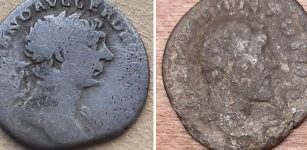 Unique Discovery – 2,000-Year-Old Roman Coins Found On Gotska Sandön In Sweden
Archaeology | Apr 13, 2023
Unique Discovery – 2,000-Year-Old Roman Coins Found On Gotska Sandön In Sweden
Archaeology | Apr 13, 2023 -
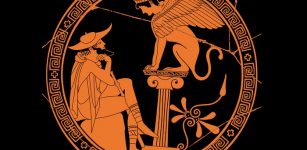 Oedipus – Tragic Prophecy About A Man Who Couldn’t Escape Fate
Featured Stories | Jan 10, 2019
Oedipus – Tragic Prophecy About A Man Who Couldn’t Escape Fate
Featured Stories | Jan 10, 2019 -
 1,750-Year-Old Fresco Travertines Buried Underground – Recovered In Ancient Laodicea
Archaeology | Mar 19, 2020
1,750-Year-Old Fresco Travertines Buried Underground – Recovered In Ancient Laodicea
Archaeology | Mar 19, 2020 -
 The Mystery Of Blinking Mummy Of Rosalia Lombardo
Featured Stories | Jun 23, 2014
The Mystery Of Blinking Mummy Of Rosalia Lombardo
Featured Stories | Jun 23, 2014 -
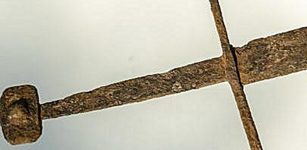 Medieval Well-Preserved Sword Discovered In A Peat Bog In Poland
Archaeology | Jun 21, 2017
Medieval Well-Preserved Sword Discovered In A Peat Bog In Poland
Archaeology | Jun 21, 2017 -
 Decebalus – The Brave One’ – Last Mighty King Of Dacian People
Featured Stories | Jun 23, 2022
Decebalus – The Brave One’ – Last Mighty King Of Dacian People
Featured Stories | Jun 23, 2022 -
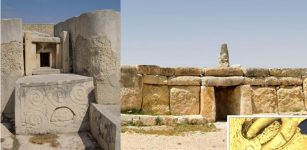 First People To Inhabit Malta Arrived 700 Years Earlier Than Previously Thought
Archaeology | Mar 20, 2018
First People To Inhabit Malta Arrived 700 Years Earlier Than Previously Thought
Archaeology | Mar 20, 2018 -
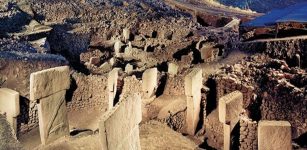 Ancient Astronomical Symbols At Göbekli Tepe Confirm A Comet Swarm Struck The Earth 11,000 B.C.
Archaeology | Apr 23, 2017
Ancient Astronomical Symbols At Göbekli Tepe Confirm A Comet Swarm Struck The Earth 11,000 B.C.
Archaeology | Apr 23, 2017 -
 Mystery Of The Ancient Unknown Mining Civilization In North America – Puzzling Archaeological Discoveries – Part 1
Civilizations | Apr 18, 2022
Mystery Of The Ancient Unknown Mining Civilization In North America – Puzzling Archaeological Discoveries – Part 1
Civilizations | Apr 18, 2022 -
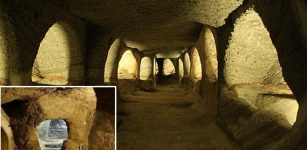 Znojmo Catacombs – Huge Underground Labyrinth Under A Medieval City
Featured Stories | Jan 17, 2016
Znojmo Catacombs – Huge Underground Labyrinth Under A Medieval City
Featured Stories | Jan 17, 2016 -
 Why Was The Pineapple A Status Symbol Once?
Ancient History Facts | Feb 12, 2024
Why Was The Pineapple A Status Symbol Once?
Ancient History Facts | Feb 12, 2024 -
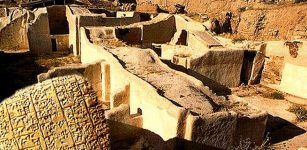 Controversial Discovery : 15,000 Ancient Ebla Tablets Prove Old Testament To Be Accurate
Archaeology | Oct 5, 2015
Controversial Discovery : 15,000 Ancient Ebla Tablets Prove Old Testament To Be Accurate
Archaeology | Oct 5, 2015 -
 Viking Grave And Sword Discovered In Norwegian Garden
Archaeology | Jul 3, 2023
Viking Grave And Sword Discovered In Norwegian Garden
Archaeology | Jul 3, 2023 -
 Secret Dwelling Place Of Reptilian And Dragon-Like Creatures In Europe
Featured Stories | Jul 18, 2018
Secret Dwelling Place Of Reptilian And Dragon-Like Creatures In Europe
Featured Stories | Jul 18, 2018 -
 Hawass Says Claims That The Ancient Egyptian Civilization Was Black Are Lies
Civilizations | Jun 21, 2024
Hawass Says Claims That The Ancient Egyptian Civilization Was Black Are Lies
Civilizations | Jun 21, 2024 -
 The 100-Kilometer-Long Stone Highway That Connected Ancient Maya Cities Revealed By LIDAR
Archaeology | Feb 25, 2020
The 100-Kilometer-Long Stone Highway That Connected Ancient Maya Cities Revealed By LIDAR
Archaeology | Feb 25, 2020
